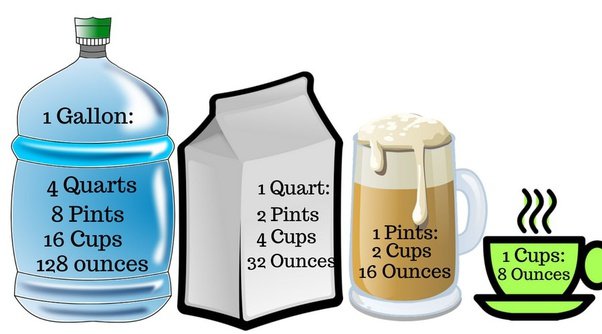How Many Ounces are in a Gallon? A Comprehensive Guide
Understanding volume measurements is essential for various applications, including cooking, baking, and scientific experiments. One common question that arises is how many ounces are in a gallon. This article will explore the conversion between gallons and ounces, the importance of accurate measurements, practical applications, and much more.
1. Introduction
The measurement of volume is crucial in many areas, from cooking to scientific research. Knowing how to convert between different units of measurement, such as gallons and ounces, can help ensure accuracy in recipes, experiments, and other applications. This article will provide a detailed exploration of how many ounces are in a gallon, along with practical examples and tips for accurate measurement.
2. Understanding Gallons and Ounces
2.1 Gallons
A gallon is a unit of volume commonly used in the United States and other countries. There are two main types of gallons:
- U.S. Gallon: This is the most commonly used gallon in the United States, equivalent to 128 fluid ounces.
- Imperial Gallon: Used primarily in the United Kingdom and some Commonwealth countries, the imperial gallon is equivalent to approximately 160 fluid ounces.
2.2 Ounces
An ounce is a smaller unit of volume. In the context of liquid measurements, we typically refer to fluid ounces (fl oz). There are two types of fluid ounces:
- U.S. Fluid Ounce: This is the standard fluid ounce used in the United States, equivalent to approximately 29.5735 milliliters.
- Imperial Fluid Ounce: Used in the UK, this fluid ounce is slightly larger, equivalent to approximately 28.4131 milliliters.
3. Conversion Between Gallons and Ounces
3.1 U.S. Gallons vs. Imperial Gallons
When converting gallons to ounces, it is essential to distinguish between U.S. gallons and imperial gallons, as they have different values.
- U.S. Gallon: 1 U.S. gallon = 128 U.S. fluid ounces
- Imperial Gallon: 1 imperial gallon = 160 imperial fluid ounces
3.2 Conversion Factors
To convert gallons to ounces, you can use the following formulas:
- U.S. Gallons to U.S. Ounces:
Ounces=Gallons×128
- Imperial Gallons to Imperial Ounces:
Ounces=Gallons×160
3.3 Example Conversions
- Example 1: Convert 2 U.S. gallons to ounces.
Ounces=2 gallons×128=256 ounces
- Example 2: Convert 3 imperial gallons to ounces.
Ounces=3 gallons×160=480 ounces
4. Practical Applications of Gallons and Ounces
Understanding the conversion between gallons and ounces is useful in various practical situations:
4.1 Cooking and Baking
In cooking and baking, recipes often use different units of measurement. Knowing how to convert between gallons and ounces can help you accurately measure ingredients. For example, if a recipe calls for 1 gallon of milk, you can easily convert it to ounces for more precise measurements.
4.2 Beverage Industry
In the beverage industry, understanding volume measurements is crucial for packaging and distribution. Many beverages are sold in gallons, while others may be measured in ounces. Accurate conversions help ensure consistency in product labeling.
4.3 Automotive and Engineering
In automotive and engineering applications, fluids such as oil and coolant are often measured in gallons or ounces. Accurate measurements are vital for proper maintenance and operation.
5. Importance of Accurate Measurements
Accurate measurements are crucial in various fields for several reasons:
5.1 Consistency
Using precise measurements ensures that recipes and formulas yield consistent results every time. This is especially important in baking, where the balance of ingredients can significantly affect the final product.
5.2 Safety
In scientific experiments and industrial applications, accurate measurements are essential for safety. Incorrect measurements can lead to dangerous situations or equipment failures.
5.3 Quality Control
In manufacturing and production, accurate measurements are vital for quality control. Ensuring that products meet specified measurements helps maintain standards and customer satisfaction.
6. Common Measurement Mistakes
When measuring liquids, several common mistakes can lead to inaccuracies. Here are some tips to avoid these pitfalls:
6.1 Using the Wrong Measuring Tools
Using the wrong type of measuring cup can lead to incorrect measurements. For example, using a dry measuring cup for liquids can result in overflow or inaccurate readings.
6.2 Not Leveling Off Dry Ingredients
When measuring dry ingredients like flour or sugar, it’s important to level off the top of the measuring cup with a straight edge. This ensures you’re not adding too much or too little.
6.3 Ignoring Temperature Effects
Temperature can affect the volume of certain liquids. For example, warm liquids may expand, leading to inaccurate measurements if not accounted for.
6.4 Eye Level Measurement
When measuring liquids in a glass measuring cup, ensure that you are at eye level with the measurement lines. This helps avoid parallax errors that can occur when viewing from above or below.
7. Conclusion
Understanding how many ounces are in a gallon is essential for accurate measurements in cooking, baking, and various scientific applications. By mastering these conversions and being mindful of common measurement mistakes, you can enhance your skills in the kitchen and ensure precision in your work.
8. Frequently Asked Questions (FAQ)
How many ounces are in a gallon?
There are 128 U.S. fluid ounces in a U.S. gallon and 160 imperial fluid ounces in an imperial gallon.
How do I convert gallons to ounces?
To convert gallons to ounces, multiply the number of gallons by 128 for U.S. gallons or by 160 for imperial gallons.
Why is accurate measurement important?
Accurate measurement is important for ensuring consistent results in cooking, baking, scientific experiments, and industrial processes.
Can I convert gallons to ounces for any recipe?
Yes, you can convert gallons to ounces using the conversion factors provided.
What is the best way to measure liquids?
Use a liquid measuring cup for liquids and ensure that you are at eye level with the measurement lines for accuracy.
Where can I find more information about volume measurements?
For more information, you can refer to the Wikipedia page on Volume.
Summary Table
| Measurement Type | Conversion Factor |
|---|---|
| 1 U.S. gallon | 128 U.S. fluid ounces |
| 1 imperial gallon | 160 imperial fluid ounces |
This comprehensive guide provides a thorough understanding of the conversion between gallons and ounces, emphasizing the importance of accurate measurements in various applications. By mastering these conversions, you can enhance your skills in cooking, baking, and scientific endeavors, ensuring that your results are consistent and reliable.



